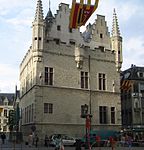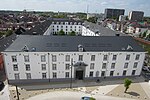Mechelen

Mechelen (Dutch pronunciation: [ˈmɛxələ(n)] (listen); French: Malines [malin]; traditional English name: Mechlin) is a city and municipality in the province of Antwerp in the Flemish Region of Belgium. The municipality comprises the city of Mechelen proper, some quarters at its outskirts, the hamlets of Nekkerspoel (adjacent) and Battel (a few kilometers away), as well as the villages of Walem, Heffen, Leest, Hombeek, and Muizen. The Dyle (Dutch: Dijle) flows through the city, hence it is often referred to as the Dijlestad ("City on the river Dijle"). Mechelen lies on the major urban and industrial axis Brussels–Antwerp, about 25 km from each city. Inhabitants find employment at Mechelen's southern industrial and northern office estates, as well as at offices or industry near the capital and Zaventem Airport, or at industrial plants near Antwerp's seaport. Mechelen is one of Flanders' prominent cities of historical art, with Antwerp, Bruges, Brussels, Ghent, and Leuven. It was notably a centre for artistic production during the Northern Renaissance, when painters, printmakers, illuminators and composers of polyphony were attracted by patrons such as Margaret of York, Margaret of Austria and Hieronymus van Busleyden.
Excerpt from the Wikipedia article Mechelen (License: CC BY-SA 3.0, Authors, Images).Mechelen
Grote Markt, Mechelen
Geographical coordinates (GPS) Address Nearby Places Show on map
Geographical coordinates (GPS)
| Latitude | Longitude |
|---|---|
| N 51.027777777778 ° | E 4.4805555555556 ° |
Address
Grote Markt 27
2800 Mechelen (Mechelen)
Antwerp, Belgium
Open on Google Maps









